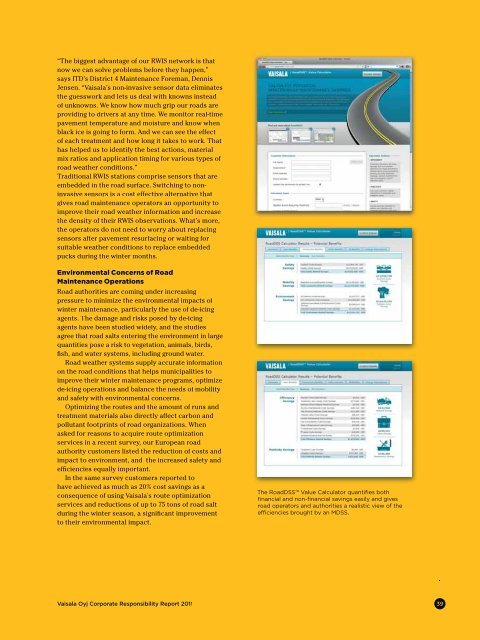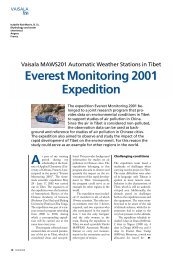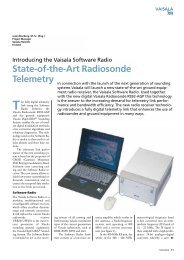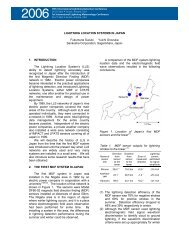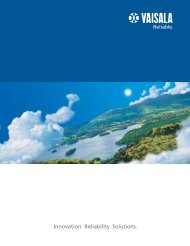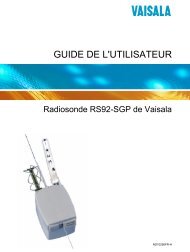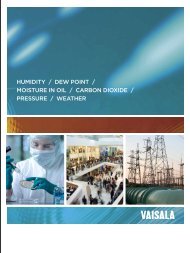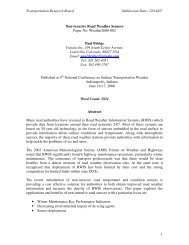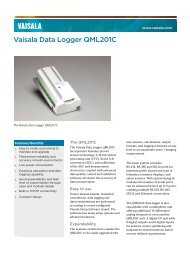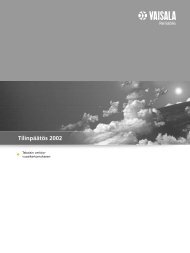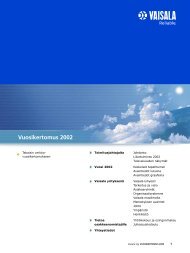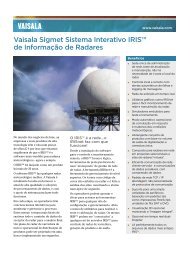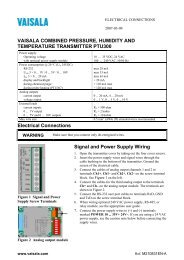Vaisala Corporate Responsibility Report 2011
Vaisala Corporate Responsibility Report 2011
Vaisala Corporate Responsibility Report 2011
Create successful ePaper yourself
Turn your PDF publications into a flip-book with our unique Google optimized e-Paper software.
“The biggest advantage of our RWIS network is that<br />
now we can solve problems before they happen,”<br />
says ITD’s District 4 Maintenance Foreman, Dennis<br />
Jensen. “<strong>Vaisala</strong>’s non-invasive sensor data eliminates<br />
the guesswork and lets us deal with knowns instead<br />
of unknowns. We know how much grip our roads are<br />
providing to drivers at any time. We monitor real-time<br />
pavement temperature and moisture and know when<br />
black ice is going to form. And we can see the effect<br />
of each treatment and how long it takes to work. That<br />
has helped us to identify the best actions, material<br />
mix ratios and application timing for various types of<br />
road weather conditions.”<br />
Traditional RWIS stations comprise sensors that are<br />
embedded in the road surface. Switching to noninvasive<br />
sensors is a cost effective alternative that<br />
gives road maintenance operators an opportunity to<br />
improve their road weather information and increase<br />
the density of their RWIS observations. What’s more,<br />
the operators do not need to worry about replacing<br />
sensors after pavement resurfacing or waiting for<br />
suitable weather conditions to replace embedded<br />
pucks during the winter months.<br />
Environmental Concerns of Road<br />
Maintenance Operations<br />
Road authorities are coming under increasing<br />
pressure to minimize the environmental impacts of<br />
winter maintenance, particularly the use of de-icing<br />
agents. The damage and risks posed by de-icing<br />
agents have been studied widely, and the studies<br />
agree that road salts entering the environment in large<br />
quantities pose a risk to vegetation, animals, birds,<br />
fish, and water systems, including ground water.<br />
Road weather systems supply accurate information<br />
on the road conditions that helps municipalities to<br />
improve their winter maintenance programs, optimize<br />
de-icing operations and balance the needs of mobility<br />
and safety with environmental concerns.<br />
Optimizing the routes and the amount of runs and<br />
treatment materials also directly affect carbon and<br />
pollutant footprints of road organizations. When<br />
asked for reasons to acquire route optimization<br />
services in a recent survey, our European road<br />
authority customers listed the reduction of costs and<br />
impact to environment, and the increased safety and<br />
efficiencies equally important.<br />
In the same survey customers reported to<br />
have achieved as much as 20% cost savings as a<br />
consequence of using <strong>Vaisala</strong>'s route optimization<br />
services and reductions of up to 75 tons of road salt<br />
during the winter season, a significant improvement<br />
to their environmental impact.<br />
The RoadDSS Value Calculator quantifies both<br />
financial and non-financial savings easily and gives<br />
road operators and authorities a realistic view of the<br />
efficiencies brought by an MDSS.<br />
<strong>Vaisala</strong> Oyj <strong>Corporate</strong> <strong>Responsibility</strong> <strong>Report</strong> <strong>2011</strong><br />
39


